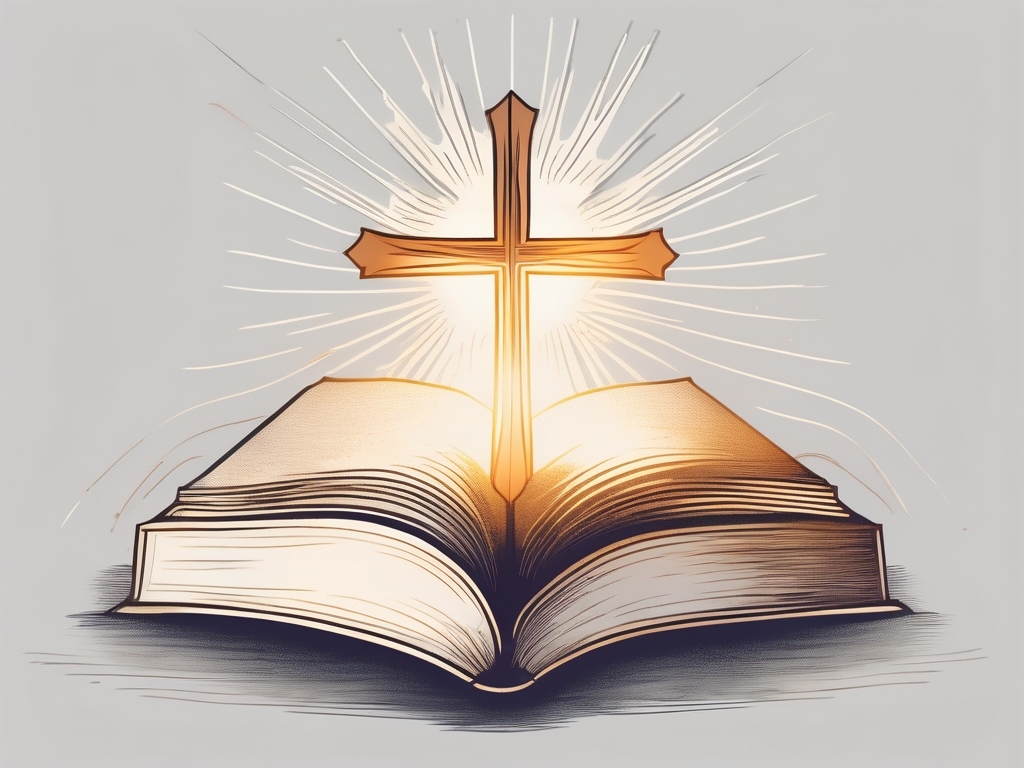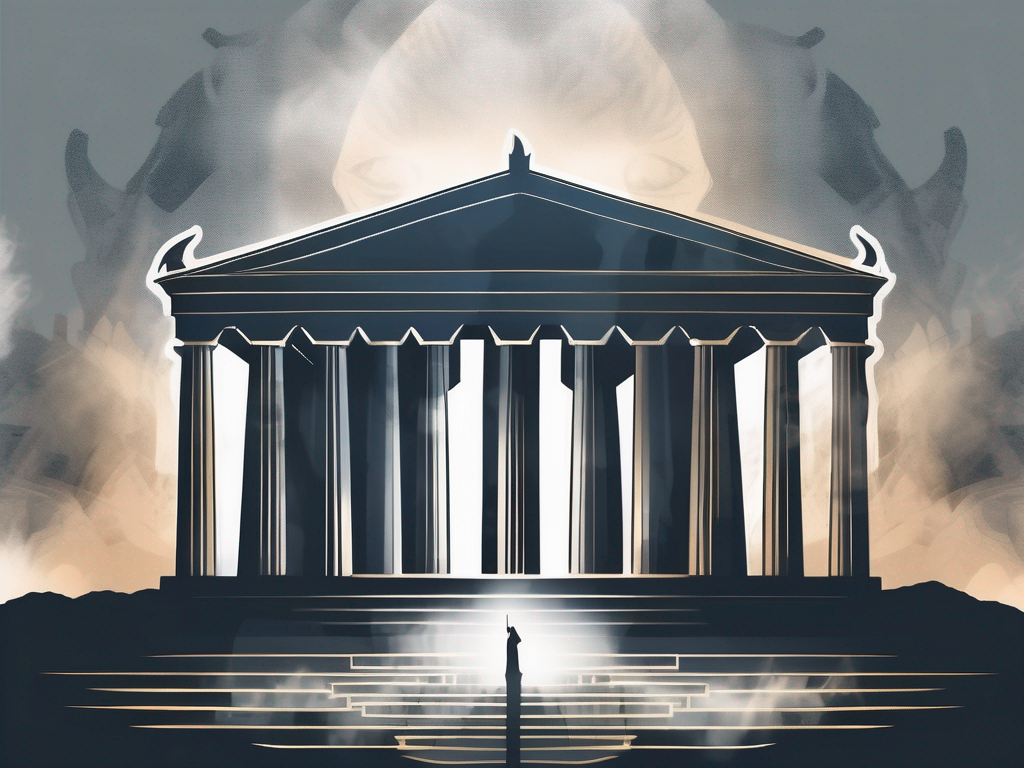In the vast and complex pantheon of Egyptian gods, perhaps none is more mysterious than the deity known as Heret-Kau. This enigmatic and often overlooked figure holds a unique place in ancient Egyptian mythology, with a story that unravels the very fabric of creation itself. In this article, we will delve deep into the myth of Heret-Kau, exploring its origins, role in Egyptian mythology, iconography, worship, and even its influence on modern culture.
Understanding the Myth of Heret-Kau
At first glance, the name Heret-Kau might not ring a bell for even the most knowledgeable Egyptology enthusiast. This is largely due to the limited references and fragmented nature of the deity’s mythology. However, a closer examination reveals a fascinating tale that sheds light on the ancient Egyptians’ understanding of creation and the divine.
Heret-Kau, a deity of great significance in ancient Egyptian mythology, represents the merging of two fundamental concepts in Egyptian cosmology – “Heret” (formlessness) and “Kau” (vital essence). These two concepts, when combined, give rise to a powerful force that played a vital role in the creation of the universe.
The Origin of Heret-Kau
The exact origins of Heret-Kau remain shrouded in mystery. Some scholars argue that Heret-Kau was an early manifestation of a primordial deity, while others believe that it emerged during the later stages of Egyptian mythology. Regardless of its beginnings, Heret-Kau holds a significant place in the ancient Egyptian pantheon.
According to ancient texts, Heret-Kau emerged as the personification of the energy and life force that gives structure and purpose to the world we live in. When the primordial waters of Nun took shape and form, Heret-Kau was born, symbolizing the essence that brings order and meaning to the universe.
It is important to note that Heret-Kau’s role in creation extends beyond the physical world. The deity represents the divine energy that permeates all aspects of existence, from the natural world to the spiritual realm.
Heret-Kau in Ancient Egyptian Literature
Although references to Heret-Kau are scarce in surviving ancient texts, the deity does make appearances in notable works such as “The Pyramid Texts” and “The Book of the Dead.” In these texts, Heret-Kau is often described as a powerful and protective force, aiding the deceased in their journey towards the afterlife.
The fact that Heret-Kau is mentioned in funerary texts suggests a close association with ideas of rebirth, regeneration, and the eternal cycle of life. The ancient Egyptians believed that death was not the end but rather a transition to a new phase of existence. Heret-Kau, with its connection to the afterlife, played a crucial role in guiding and safeguarding the souls of the departed.
Furthermore, Heret-Kau’s presence in funerary texts highlights the belief in the continuity of life and the cyclical nature of existence. Just as the sun rises and sets, and the seasons change, the ancient Egyptians saw life as an eternal cycle, with death being merely a part of the journey.
Heret-Kau’s association with rebirth and regeneration also reflects the Egyptians’ deep-rooted belief in the power of transformation. They believed that through death and subsequent rebirth, one could attain a higher state of being, transcending the limitations of mortal existence.
In conclusion, while the mythology surrounding Heret-Kau may be fragmented, it offers valuable insights into the ancient Egyptians’ understanding of creation, the divine, and the eternal cycle of life. The deity’s role in the universe, as well as its significance in guiding souls towards the afterlife, showcases the profound spiritual beliefs that shaped the civilization of ancient Egypt.
The Role and Significance of Heret-Kau in Egyptian Mythology
Within the complex tapestry of Egyptian mythology, Heret-Kau assumes several roles and responsibilities. Let us explore two prominent aspects that shed light on the significance of this mystical deity.
Heret-Kau: The Protector of the King
In the pharaoh-centric society of ancient Egypt, the king held the divine mandate to lead and protect his people. However, this divine authority could not be exercised without the watchful eye of the gods. One such god was Heret-Kau, who was believed to act as a powerful guardian and defender of the Egyptian monarch.
Historical records suggest that Heret-Kau’s protection was not limited to the physical realm. It was said that the deity’s presence ensured the pharaoh’s enduring connection with the divine, serving as a conduit for the king’s divine essence and authority.
Heret-Kau’s role as the protector of the king extended beyond the mortal realm. It was believed that the deity’s watchful gaze encompassed not only the pharaoh’s physical well-being but also his spiritual journey. In times of war or political turmoil, the pharaoh would call upon Heret-Kau for guidance and protection, seeking the deity’s divine intervention to secure victory and maintain order within the kingdom.
The Egyptian people revered Heret-Kau as a symbol of stability and strength. The deity’s presence in the king’s life was seen as a guarantee of the ruler’s legitimacy and the prosperity of the kingdom. The pharaoh, in turn, would honor Heret-Kau through lavish rituals and offerings, acknowledging the deity’s crucial role in maintaining the balance between the mortal and divine realms.
Heret-Kau and the Afterlife
As mentioned earlier, Heret-Kau’s association with the afterlife was of great importance to the ancient Egyptians. It was believed that Heret-Kau played a pivotal role in guiding the deceased on their journey through the perilous realms of the underworld.
Upon death, it was believed that the deceased’s soul would be tested and judged before reaching its final resting place. Heret-Kau, with its profound knowledge of the afterlife, was thought to assist in navigating these trials and ensuring a successful transition from the mortal realm to the realm of the gods.
Heret-Kau was often depicted as a fierce and protective deity, armed with the power to ward off evil spirits and malevolent forces that lurked in the underworld. The ancient Egyptians believed that by invoking the name of Heret-Kau and seeking the deity’s guidance, they could secure a safe passage for their departed loved ones.
Furthermore, Heret-Kau’s role extended beyond guiding the deceased through the afterlife. The deity was also believed to have the ability to grant blessings and bestow divine favor upon the souls of the departed. It was thought that those who had lived virtuous lives and honored the gods would receive Heret-Kau’s benevolence, ensuring a blissful existence in the divine realm.
The belief in Heret-Kau’s involvement in the afterlife was so deeply ingrained in Egyptian culture that elaborate funerary rituals and ceremonies were conducted to honor the deity. These rituals included the recitation of prayers and the offering of food, drink, and other material goods to ensure the deceased’s successful journey and eternal happiness.
In conclusion, Heret-Kau played a crucial role in Egyptian mythology as the protector of the king and guide of the afterlife. The deity’s presence symbolized the divine authority of the pharaoh and ensured the ruler’s connection with the gods. Additionally, Heret-Kau’s association with the afterlife provided comfort and reassurance to the ancient Egyptians, who believed in the deity’s ability to guide and protect the souls of the departed.
The Iconography of Heret-Kau
The visual representation of Heret-Kau provides invaluable insights into the deity’s nature and symbolism. Ancient Egyptian art often portrayed the deity using elaborate and intricate imagery that conveyed deeper meanings.
Depictions of Heret-Kau in Ancient Art
In artistic renderings, Heret-Kau is often depicted as a fearsome and majestic figure, combining elements of divine authority and chaos. The deity is frequently represented with the head of a falcon, symbolizing strength and vision, while its body is adorned with various royal and animalistic attributes.
The choice of animal symbolism in ancient Egyptian art was deliberate and carried significant meaning. The falcon, for instance, represented power, protection, and divine authority, all qualities associated with Heret-Kau and its role in Egyptian mythology.
Symbolism and Attributes of Heret-Kau
Beyond its physical representation, Heret-Kau’s iconography also incorporates a myriad of symbolic elements. The deity is often depicted holding an ankh, the symbol of life, signifying its association with creation, regeneration, and the eternal cycle of existence.
Additionally, Heret-Kau’s ability to traverse between worlds and navigate the afterlife is symbolized by its wings, which signify freedom and ascendance. This juxtaposition of opposing symbols reflects the duality and power inherent in the deity.
Worship and Cult of Heret-Kau
The worship of Heret-Kau was not as widespread or well-documented as that of other prominent deities in ancient Egypt. Despite this, evidence suggests that Heret-Kau had a dedicated following and was venerated through various rituals and ceremonies.
Temples and Shrines Dedicated to Heret-Kau
While no grand temples dedicated exclusively to Heret-Kau have been discovered, smaller shrines and sanctuaries devoted to the deity have been found throughout Egypt. These structures served as gathering places for devotees seeking the blessings and protection of Heret-Kau.
These sacred spaces were adorned with images and symbols associated with Heret-Kau, and rituals performed there were believed to strengthen the bond between worshippers and the deity.
Rituals and Ceremonies in Honor of Heret-Kau
Details regarding the specific rituals and ceremonies dedicated to Heret-Kau are scarce. However, it is believed that offerings such as incense, food, and libations were made to the deity as a means of appeasement and communication.
Moreover, it is thought that the worship of Heret-Kau was closely tied to rituals surrounding death and the afterlife. These rites aimed to ensure the protection and guidance of the deceased, as well as their eternal connection with the divine and Heret-Kau itself.
Heret-Kau’s Influence on Modern Culture
While ancient Egyptian mythology might seem distant and detached from our modern world, the legacy of Heret-Kau can still be found in various forms of art, literature, and popular media.
Heret-Kau in Popular Literature and Media
Authors and filmmakers around the world have drawn inspiration from the rich tapestry of Egyptian mythology, and Heret-Kau is no exception. This mystical deity has made appearances in numerous books and movies, captivating the imaginations of audiences and breathing new life into an ancient belief system.
From epic fantasy novels to blockbuster movies, Heret-Kau’s presence continues to resonate with people and keeps the spirit of Egyptian mythology alive in the modern era.
The Legacy of Heret-Kau in Contemporary Egyptology
Despite its relative obscurity within ancient Egyptian mythology, the study and exploration of Heret-Kau have contributed significantly to our understanding of this ancient civilization. Through diligent research and analysis, Egyptologists have pieced together fragments of information, shedding light on the broader tapestry of Egyptian mythology and culture.
Moreover, discoveries related to Heret-Kau have helped deepen our understanding of the complex relationship between the Egyptians and their gods, offering valuable insights into their beliefs, rituals, and worldview.
In conclusion, the mythical deity Heret-Kau remains a compelling enigma within the pantheon of Egyptian gods. Its story, though shrouded in mystery, unveils a glimpse into the ancient Egyptians’ perception of creation, protection, and the afterlife. Through exploration of its origins, roles, symbolism, worship, and modern influence, we are reminded of the enduring power and fascination of Egyptian mythology. So, let us continue to unveil the secrets of Heret-Kau, the guardian of kings and the guide to eternity.












